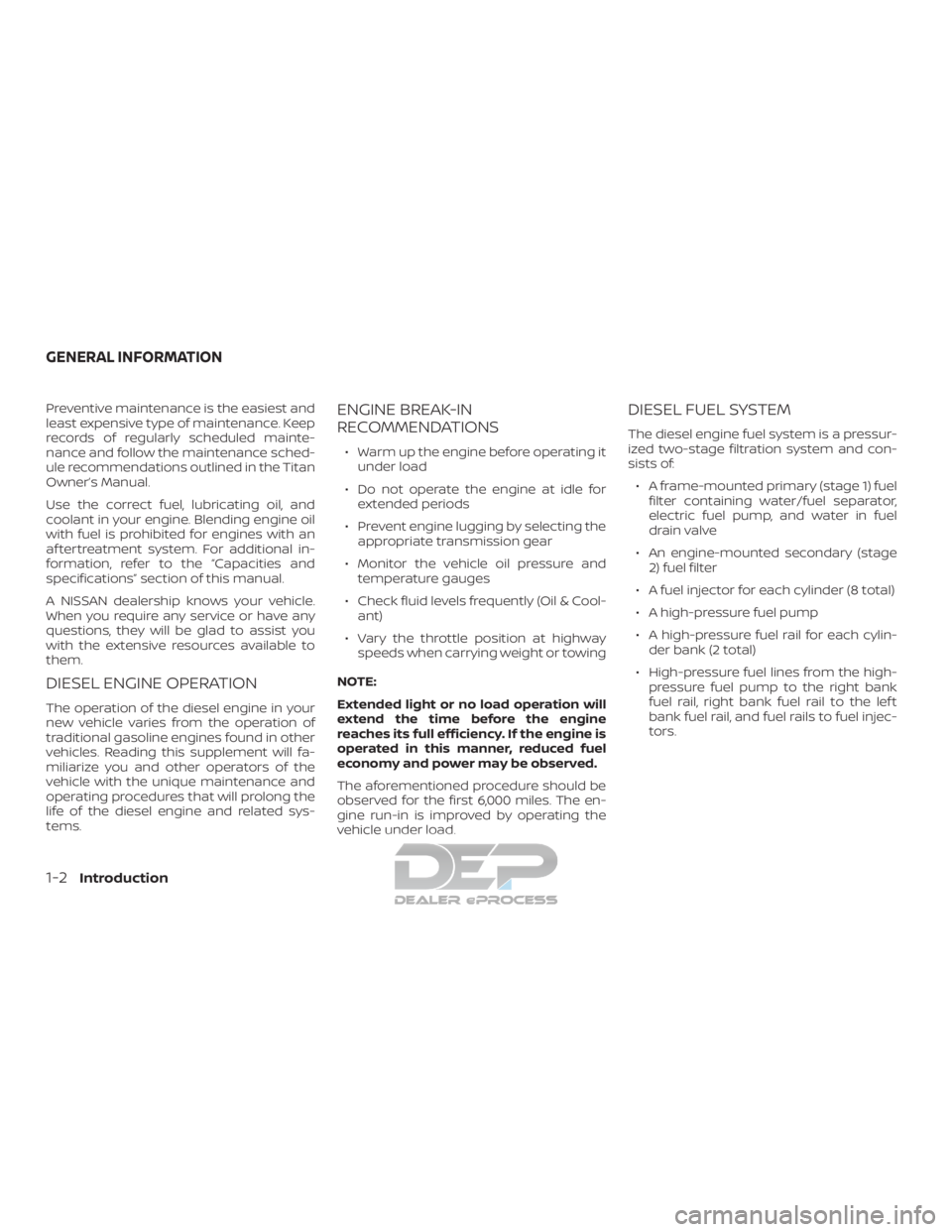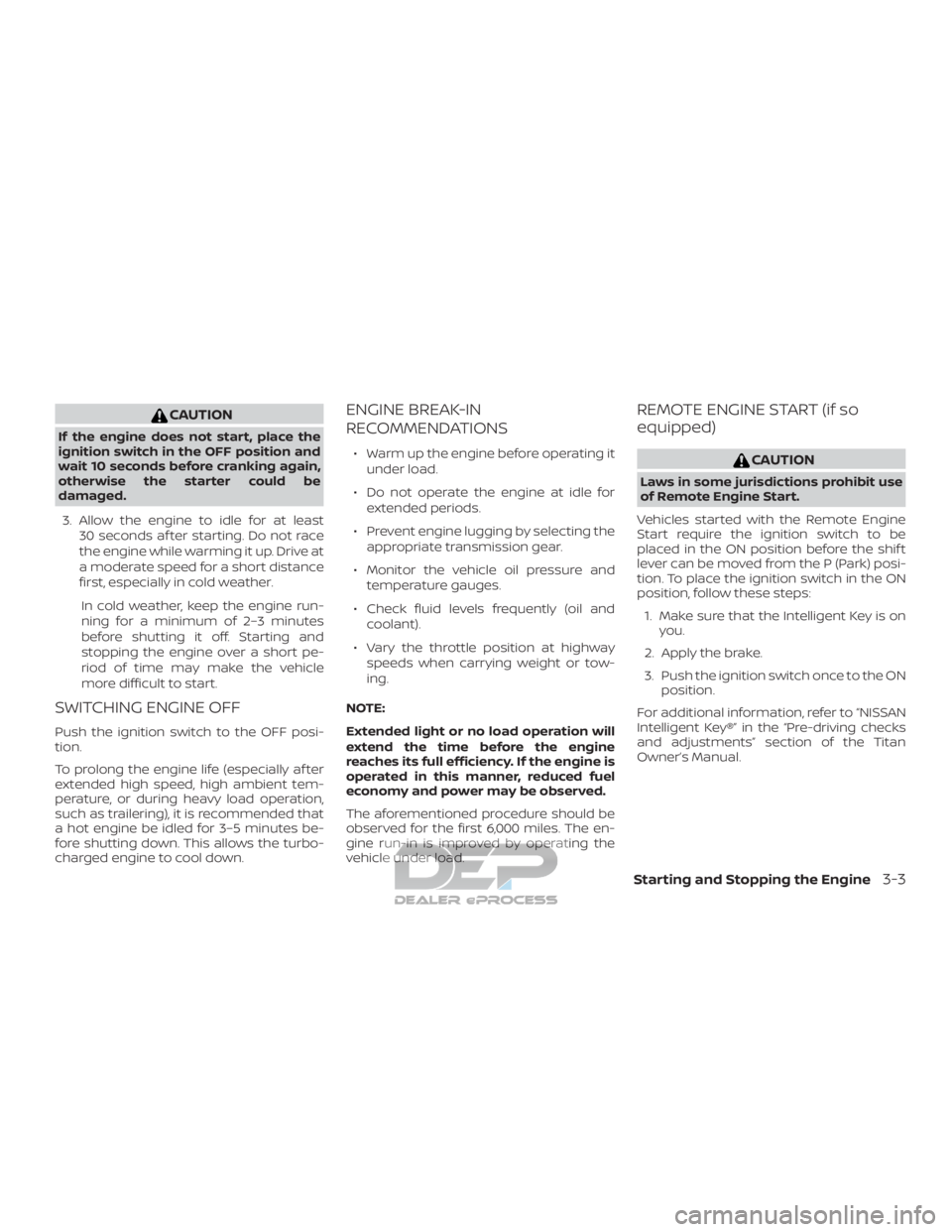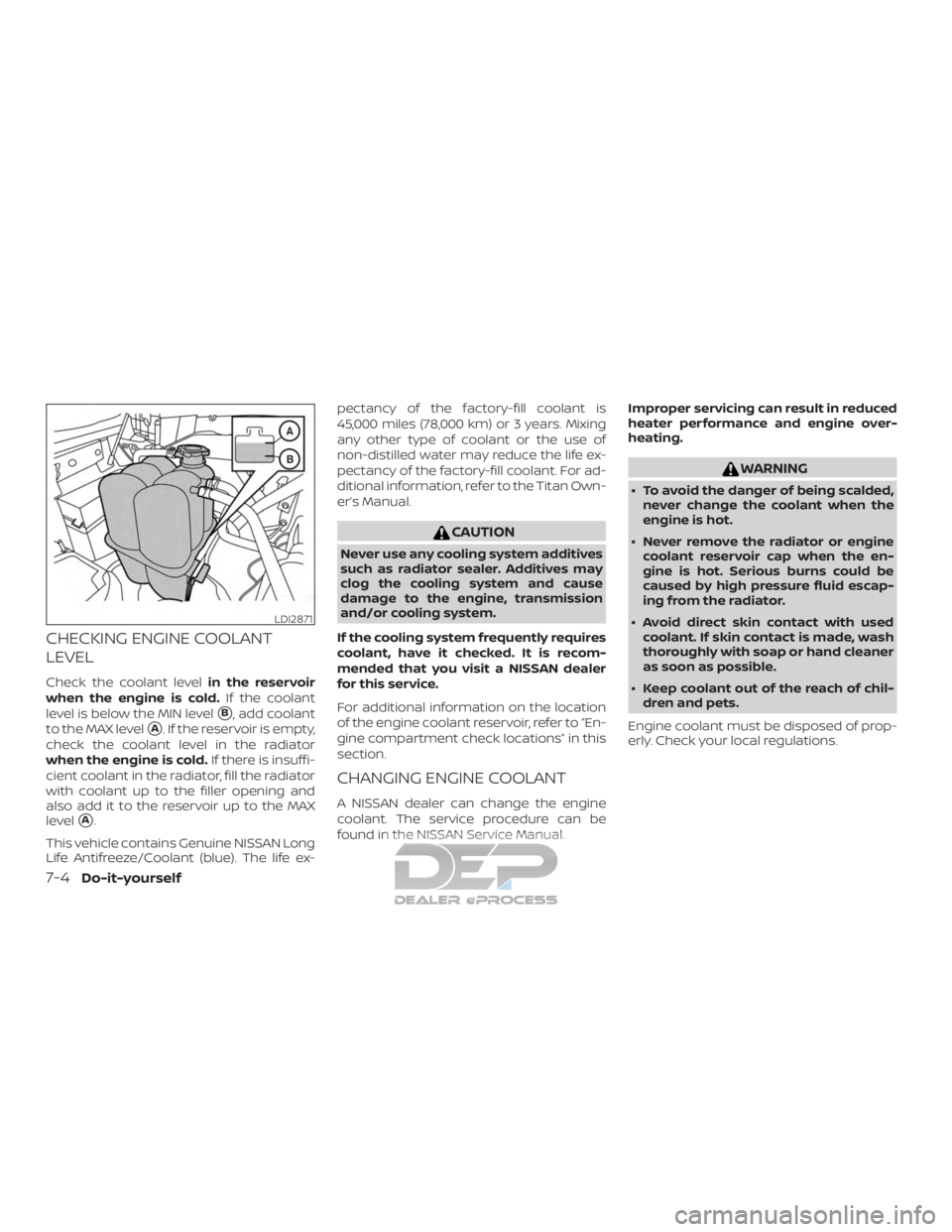Page 623 of 682

Preventive maintenance is the easiest and
least expensive type of maintenance. Keep
records of regularly scheduled mainte-
nance and follow the maintenance sched-
ule recommendations outlined in the Titan
Owner’s Manual.
Use the correct fuel, lubricating oil, and
coolant in your engine. Blending engine oil
with fuel is prohibited for engines with an
af tertreatment system. For additional in-
formation, refer to the “Capacities and
specifications” section of this manual.
A NISSAN dealership knows your vehicle.
When you require any service or have any
questions, they will be glad to assist you
with the extensive resources available to
them.
DIESEL ENGINE OPERATION
The operation of the diesel engine in your
new vehicle varies from the operation of
traditional gasoline engines found in other
vehicles. Reading this supplement will fa-
miliarize you and other operators of the
vehicle with the unique maintenance and
operating procedures that will prolong the
life of the diesel engine and related sys-
tems.
ENGINE BREAK-IN
RECOMMENDATIONS
∙ Warm up the engine before operating itunder load
∙ Do not operate the engine at idle for extended periods
∙ Prevent engine lugging by selecting the appropriate transmission gear
∙ Monitor the vehicle oil pressure and temperature gauges
∙ Check fluid levels frequently (Oil & Cool- ant)
∙ Vary the throttle position at highway speeds when carrying weight or towing
NOTE:
Extended light or no load operation will
extend the time before the engine
reaches its full efficiency. If the engine is
operated in this manner, reduced fuel
economy and power may be observed.
The aforementioned procedure should be
observed for the first 6,000 miles. The en-
gine run-in is improved by operating the
vehicle under load.
DIESEL FUEL SYSTEM
The diesel engine fuel system is a pressur-
ized two-stage filtration system and con-
sists of: ∙ A frame-mounted primary (stage 1) fuel filter containing water/fuel separator,
electric fuel pump, and water in fuel
drain valve
∙ An engine-mounted secondary (stage 2) fuel filter
∙ A fuel injector for each cylinder (8 total)
∙ A high-pressure fuel pump
∙ A high-pressure fuel rail for each cylin- der bank (2 total)
∙ High-pressure fuel lines from the high- pressure fuel pump to the right bank
fuel rail, right bank fuel rail to the lef t
bank fuel rail, and fuel rails to fuel injec-
tors.
GENERAL INFORMATION
1-2Introduction
Page 638 of 682

CAUTION
If the engine does not start, place the
ignition switch in the OFF position and
wait 10 seconds before cranking again,
otherwise the starter could be
damaged.3. Allow the engine to idle for at least 30 seconds af ter starting. Do not race
the engine while warming it up. Drive at
a moderate speed for a short distance
first, especially in cold weather.
In cold weather, keep the engine run-
ning for a minimum of 2–3 minutes
before shutting it off. Starting and
stopping the engine over a short pe-
riod of time may make the vehicle
more difficult to start.
SWITCHING ENGINE OFF
Push the ignition switch to the OFF posi-
tion.
To prolong the engine life (especially af ter
extended high speed, high ambient tem-
perature, or during heavy load operation,
such as trailering), it is recommended that
a hot engine be idled for 3–5 minutes be-
fore shutting down. This allows the turbo-
charged engine to cool down.
ENGINE BREAK-IN
RECOMMENDATIONS
∙ Warm up the engine before operating it under load.
∙ Do not operate the engine at idle for extended periods.
∙ Prevent engine lugging by selecting the appropriate transmission gear.
∙ Monitor the vehicle oil pressure and temperature gauges.
∙ Check fluid levels frequently (oil and coolant).
∙ Vary the throttle position at highway speeds when carrying weight or tow-
ing.
NOTE:
Extended light or no load operation will
extend the time before the engine
reaches its full efficiency. If the engine is
operated in this manner, reduced fuel
economy and power may be observed.
The aforementioned procedure should be
observed for the first 6,000 miles. The en-
gine run-in is improved by operating the
vehicle under load.
REMOTE ENGINE START (if so
equipped)
CAUTION
Laws in some jurisdictions prohibit use
of Remote Engine Start.
Vehicles started with the Remote Engine
Start require the ignition switch to be
placed in the ON position before the shif t
lever can be moved from the P (Park) posi-
tion. To place the ignition switch in the ON
position, follow these steps: 1. Make sure that the Intelligent Key is on you.
2. Apply the brake.
3. Push the ignition switch once to the ON position.
For additional information, refer to “NISSAN
Intelligent Key®” in the “Pre-driving checks
and adjustments” section of the Titan
Owner’s Manual.
Starting and Stopping the Engine3-3
Page 657 of 682

CHECKING ENGINE COOLANT
LEVEL
Check the coolant levelin the reservoir
when the engine is cold. If the coolant
level is below the MIN level
�B, add coolant
to the MAX level
�A. If the reservoir is empty,
check the coolant level in the radiator
when the engine is cold. If there is insuffi-
cient coolant in the radiator, fill the radiator
with coolant up to the filler opening and
also add it to the reservoir up to the MAX
level
�A.
This vehicle contains Genuine NISSAN Long
Life Antifreeze/Coolant (blue). The life ex- pectancy of the factory-fill coolant is
45,000 miles (78,000 km) or 3 years. Mixing
any other type of coolant or the use of
non-distilled water may reduce the life ex-
pectancy of the factory-fill coolant. For ad-
ditional information, refer to the Titan Own-
er’s Manual.
CAUTION
Never use any cooling system additives
such as radiator sealer. Additives may
clog the cooling system and cause
damage to the engine, transmission
and/or cooling system.
If the cooling system frequently requires
coolant, have it checked. It is recom-
mended that you visit a NISSAN dealer
for this service.
For additional information on the location
of the engine coolant reservoir, refer to “En-
gine compartment check locations” in this
section.
CHANGING ENGINE COOLANT
A NISSAN dealer can change the engine
coolant. The service procedure can be
found in the NISSAN Service Manual. Improper servicing can result in reduced
heater performance and engine over-
heating.
WARNING
∙ To avoid the danger of being scalded,
never change the coolant when the
engine is hot.
∙ Never remove the radiator or engine coolant reservoir cap when the en-
gine is hot. Serious burns could be
caused by high pressure fluid escap-
ing from the radiator.
∙ Avoid direct skin contact with used coolant. If skin contact is made, wash
thoroughly with soap or hand cleaner
as soon as possible.
∙ Keep coolant out of the reach of chil- dren and pets.
Engine coolant must be disposed of prop-
erly. Check your local regulations.
LDI2871
7-4Do-it-yourself